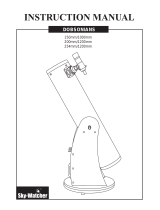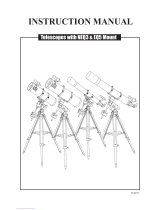
2
Table of Contents
INTRODUCTION .......................................................................................................................... 3
ASSEMBLY ................................................................................................................................... 6
Setting up the Tripod............................................................................................................................................. 6
Attaching the Equatorial Mount .......................................................................................................................... 7
Installing the Counterweight Bar & Counterweight(s) ...................................................................................... 7
Attaching the Slow Motion Cables ....................................................................................................................... 8
Attaching the Telescope Tube to the Mount........................................................................................................ 8
Installing the Diagonal & Eyepiece (Refractor) .................................................................................................. 9
Installing the Eyepiece on the Newtonian............................................................................................................ 9
Installing the Finderscope................................................................................................................................... 10
Aligning the Finderscope..................................................................................................................................... 10
Installing and Using the Barlow Lens ................................................................................................................ 10
Moving the Telescope Manually......................................................................................................................... 11
Balancing the Mount in R.A. .............................................................................................................................. 11
Balancing the Mount in Dec................................................................................................................................ 11
Adjusting the Equatorial Mount ........................................................................................................................ 12
Adjusting the Mount in Altitude......................................................................................................................... 12
TELESCOPE BASICS ................................................................................................................. 13
Image Orientation................................................................................................................................................ 14
Focusing................................................................................................................................................................ 14
Calculating Magnification................................................................................................................................... 14
Determining Field of View .................................................................................................................................. 15
General Observing Hints..................................................................................................................................... 15
ASTRONOMY BASICS .............................................................................................................. 16
The Celestial Coordinate System........................................................................................................................ 16
Motion of the Stars .............................................................................................................................................. 16
Polar Alignment with the Latitude Scale........................................................................................................... 17
Pointing at Polaris................................................................................................................................................ 18
Finding the North Celestial Pole......................................................................................................................... 18
Polar Alignment in the Southern Hemisphere .................................................................................................. 19
Aligning the Setting Circles................................................................................................................................. 21
Motor Drive.......................................................................................................................................................... 22
CELESTIAL OBSERVING ......................................................................................................... 23
Observing the Moon ............................................................................................................................................ 23
Observing the Planets.......................................................................................................................................... 23
Observing the Sun................................................................................................................................................ 23
Observing Deep-Sky Objects .............................................................................................................................. 24
Seeing Conditions................................................................................................................................................. 24
ASTROPHOTOGRAPHY............................................................................................................ 25
Short Exposure Prime Focus Photography ....................................................................................................... 25
Piggyback Photography....................................................................................................................................... 25
Planetary & Lunar Photography with Special Imagers................................................................................... 25
CCD Imaging for Deep Sky Objects .................................................................................................................. 25
Terrestrial Photography...................................................................................................................................... 25
TELESCOPE MAINTENANCE.................................................................................................. 26
Care and Cleaning of the Optics......................................................................................................................... 26
Collimation of a Newtonian................................................................................................................................. 26
OPTIONAL ACCESSORIES ..................................................................................................... 29
POWERSEEKER SPECIFICATIONS......................................................................................... 30






















